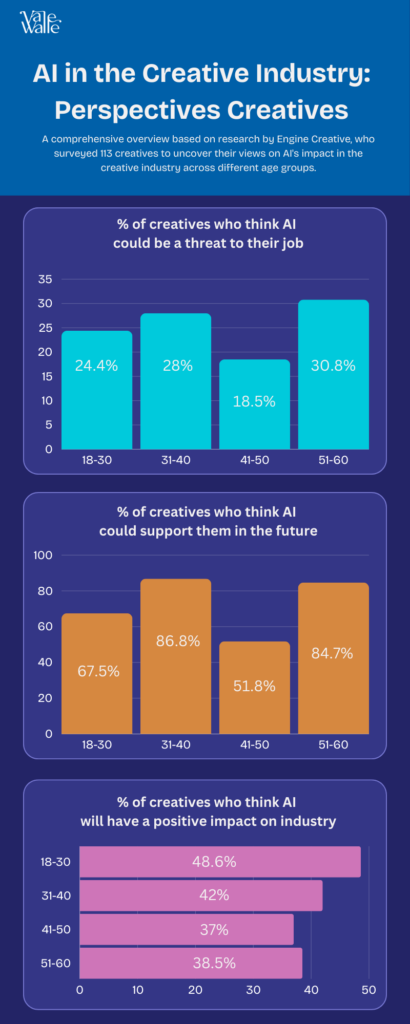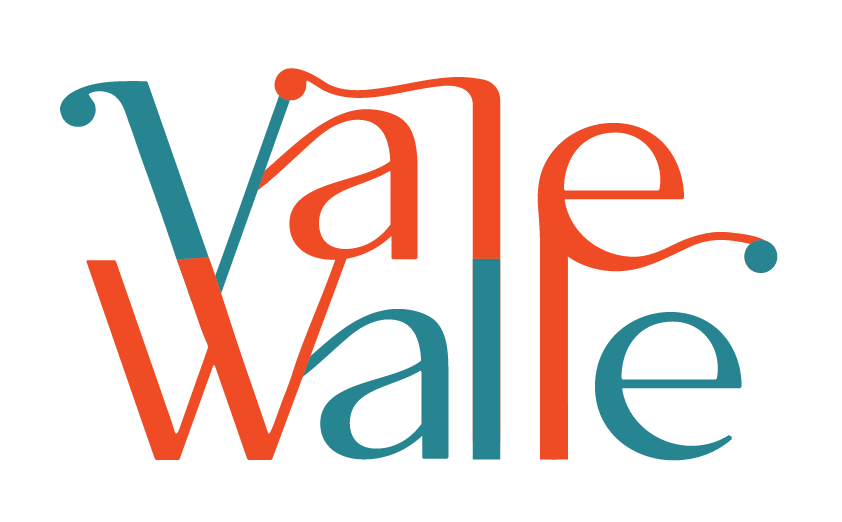AI and Graphic Design: A tool or a threat?

Infographic based on research done by Engine Creative. For additional information on the research,
visit https://www.enginecreative.co.uk/blog/artificial-intelligence-in-the-creative-industry/
In my second blog post (https://valewalle.com/2-everything-happens-for-a-reason/), I discussed my existential crisis and my fear that AI would replace me as a graphic designer. Although I talked there about how it led me to make life-changing decisions and expand my skill set, here I’ll dive deeper into this not-so-crazy fear that many designers and creatives like myself are facing.
Artificial Intelligence is growing fast, and it is true that “the graphic designers of the future need to offer different value” (SketchDeck, 2023). What do I mean by this? Essentially, that we must develop more skills that AI can’t do. I will explore this through a very interesting article on LinkedIn written by Sean Makin, a Brand Development Manager at Sctomas Group.
AI and Automation: “AI-powered tools and software can automate repetitive and time-consuming tasks such as image editing, layout design, and color matching.” This is well demonstrated in tools like Canva and Adobe Sparks, where AI algorithms suggest design layouts, fonts, and colors based on user input. Although these tools lack the emotional and cultural context that human designers bring, they can complement our work effectively.
AI and Personalization: “AI algorithms can analyze user data and behavior to generate personalized designs and content.” An example of this is Hilton Hotels’s AI robot, Connie. Connie greets guests and learns about their preferences to provide personalized recommendations for places and restaurants. While this raises ethical concerns about privacy and data manipulation, it showcases how AI can enhance customer interactions.
AI and Creativity: This is one of the most debated topics. Some argue that AI can generate more innovative designs since it can analyze large amounts of data, much like Nutella’s case where it used an algorithm to design 7 million unique labels that sold out in a month. However, I lean towards the perspective that AI lacks the emotional and cultural context that human designers possess. While there are two sides to this debate, it is undeniable that AI can assist in human creativity, again, as a tool and not as a replacement.
As we navigate through the rapidly evolving landscape of AI in graphic design, it’s clear that while AI can simplify certain processes and offer new ways to engage with content, the essence of design—its ability to connect on a human level—remains uniquely ours. As designers, our challenge is to integrate AI as a partner in our creative process, leveraging its capabilities to enhance our own creativity rather than viewing it as a rival. By doing so, we not only secure our place in the future of design but also elevate our work to new heights of innovation. Embracing AI is not about giving up our roles; it’s about enriching them and pushing the boundaries of what’s possible in our field, while we adopt to the newest technological trends and changes in the world.
“Designers and developers must balance AI and human creativity, ensuring they work together to create innovative and impactful designs that meet the client’s expectations and standards.”
-Sean Makin
Additionally, I’d like to share an issue brief I wrote about “What’s Next: The Future of Graphic Designers and AI”. Download here.
To learn more about this topic, visit:
https://www.linkedin.com/pulse/ai-replace-graphic-designers-sean-makin/
https://sketchdeck.com/blog/will-ai-replace-graphic-designers/
I’d love to hear your thoughts on this topic. Do you see AI as a tool for enhancement or a threat? Share your views in the comments below and let’s discuss!
Resources:
Makin, S. (2023, April 14). Will AI replace Graphic Designers? https://www.linkedin.com/pulse/ai-replace-graphic-designers-sean-makin/
Morgan, B. (2019, January 24). The 7 Best Examples of Artificial intelligence to improve Personalization. Forbes. https://www.forbes.com/sites/blakemorgan/2019/01/24/the-7-best-examples-of-artificial-intelligence-to-improve-personalization/
SketchDeck. (2023, February 24). Will AI replace graphic designers? – SketchDeck. https://sketchdeck.com/blog/will-ai-replace-graphic-designers/
© Valeria Wallentin, 2024

6 Responses
AI is really challenging people who work in visual, graphic, or art designers. It makes people in this fields becoming more and more competitive with technology. However, one key strength I think humans own are emotions. Emotions are complicated perception with empathy. Only work of designers is not enough anymore, the way designers’ position to public themselves matter.
Back to your interactive question “Whether AI is an enhancement or a threat”. From my opinion, I like pure art from human more than AI. I think good art comes from real feeling and nature of humans. It is more intangible value. Yet, the world and nature are also changing in this generation. Social media become a crucial part and norm in daily life. And it has been even applied in industry for proficiency.
Therefore, the threat or enhancement of AI really depends on how people use it. If we use it controlling them wisely and carefully, we could gain several benefits.
I am Siriyakorn
AI is really challenging people who work in visual, graphic, or art designers. It makes people in this fields becoming more and more competitive with technology. However, one key strength I think humans own are emotions. Emotions are complicated perception with empathy. Only work of designers is not enough anymore, the way designers’ position to public themselves matter.
Back to your interactive question “Whether AI is an enhancement or a threat”. From my opinion, I like pure art from human more than AI. I think good art comes from real feeling and nature of humans. It is more intangible value. Yet, the world and nature are also changing in this generation. Social media become a crucial part and norm in daily life. And it has been even applied in industry for proficiency.
Therefore, the threat or enhancement of AI really depends on how people use it. If we use it controlling them wisely and carefully, we could gain several benefits.
-Siriyakorn
I really liked how your post offers a deep reflection on the impact of artificial intelligence on graphic design, highlighting how this technology is transforming the profession and posing challenges and opportunities for creatives. It is essential to recognize that while AI can automate repetitive tasks and suggest designs, it lacks the emotional and cultural context that human designers bring. Integrating AI as an ally in the creative process not only strengthens innovation, but also preserves the uniqueness and human connection essential to design.
I love this topic as it has become very relevant for professionals recently. I know several established professionals who are genuinely worried that AI might replace the majority or entirety of their jobs. This is then opposed by the funny reels on Instagram highlighted how AI still has a long way to go before becoming close to perfect. Despite that, AI is an incredibly fast-growing technology. Your experience as a graphic designer and those with other artistic and creative skills can be more at risk for AI integration than other positions. For better or for worse as youve highlighted, the threat of AI forces creatives to hone and develop skills that AI cannot reproduce which I think will be the differentiating factor between man made and AI produced content.
AI is such a hot topic, not just in the technology space but in every industry. It is shaping the way we think about how we do work, what can be automated, can EVERYTHING be automated? Using your experience as a graphic designer, you make a great point in your blog. While AI can be used to simplify tasks and processes, it is up to the professional to add the human touch needed to connect with our audience. As much as technology has advanced, our need for something authentic and human still remains. Great job!